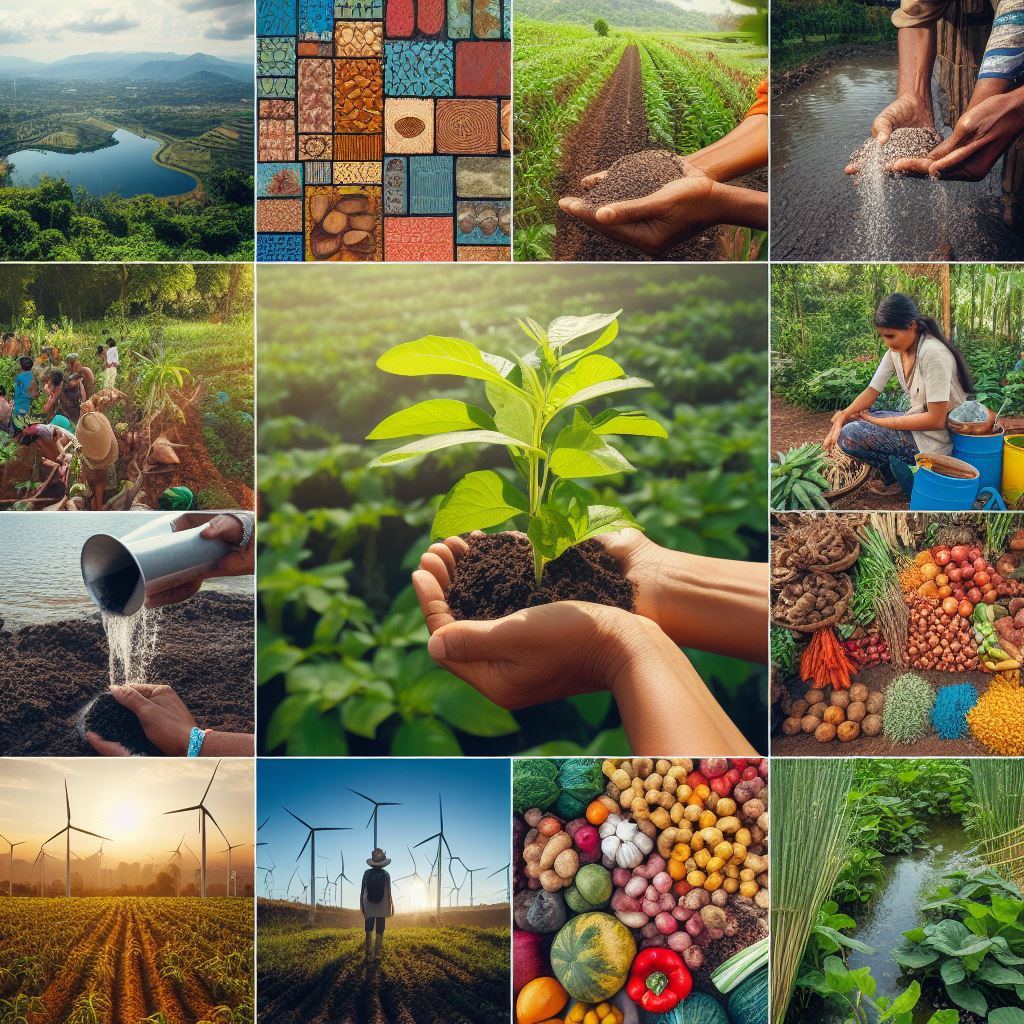Introduction
Climate-smart farming is crucial for ensuring food security, adapting to climate change, and mitigating greenhouse gas emissions.
Climate change poses significant challenges to global agriculture, including extreme weather events, shifting rainfall patterns, and rising temperatures.
These changes directly impact crop yields, livestock productivity, and overall food production.
Climate-smart farming practices focus on improving the efficiency and resilience of agricultural systems while reducing their environmental impact.
These practices include the use of climate-resilient crop varieties, precision farming techniques, efficient water management, and sustainable soil management.
Climate-smart farming not only helps farmers adapt to the changing climate but also contributes to reducing greenhouse gas emissions.
By adopting climate-smart practices, farmers can reduce their carbon footprint, enhance soil health, and promote biodiversity on their farms.
Furthermore, climate-smart farming improves the resilience of agricultural systems, making them less vulnerable to climate-related risks and ensuring stable food production.
It also helps farmers maintain their livelihoods and adapt to changing market demands and consumer preferences.
In short, climate-smart farming is essential for addressing the challenges posed by climate change to global agriculture.
By implementing sustainable and resilient practices, farmers can mitigate their environmental impact, ensure food security, and build a more sustainable future.
The Climate Crisis and Agriculture
Climate change impacts on agriculture
- Increasing temperature leads to decreased crop yields and reduced livestock productivity.
- Extreme weather events, such as droughts and floods, disrupt farming activities and destroy crops.
- Changes in precipitation patterns affect water availability, irrigation systems, and overall crop growth.
- Rising sea levels contaminate freshwater resources and render coastal farmlands unsuitable for agriculture.
- Pests and diseases, which thrive in warmer conditions, pose a significant threat to crops and livestock.
Need for sustainable farming practices
- Conventional farming methods contribute to climate change through greenhouse gas emissions and deforestation.
- Overuse of chemical fertilizers and pesticides leads to soil degradation and loss of biodiversity.
- Unsustainable irrigation practices deplete freshwater sources, exacerbating water scarcity issues.
- Soil erosion caused by inappropriate land management practices reduces agricultural productivity.
Role of climate-smart farming in addressing the climate crisis
- Climate-smart farming integrates climate change adaptation and mitigation strategies into agricultural practices.
- Conservation agriculture techniques, such as minimum tillage and crop rotation, enhance soil health and fertility.
- Agroforestry systems that combine trees and crops help sequester carbon dioxide and improve farm resilience.
- Precision farming technologies optimize resource use, reduce waste, and minimize environmental impact.
- Sustainable water management practices, such as rainwater harvesting and drip irrigation, conserve water resources.
- Integrated pest management approaches reduce chemical inputs while promoting natural pest control mechanisms.
- Climate-smart livestock farming focuses on improving animal welfare, nutrition, and reducing methane emissions.
- Farmer training and capacity-building programs enable knowledge transfer and adoption of climate-smart practices.
- Policy support and financial incentives drive the adoption of climate-smart farming at a larger scale.
- Collaboration between governments, researchers, farmers, and consumers is crucial for effective implementation.
In essence, the climate crisis poses significant challenges to agriculture, threatening food security and livelihoods.
However, sustainable and climate-smart farming practices offer solutions to mitigate and adapt to climate change.
By implementing these practices, farmers can enhance productivity, conserve natural resources, reduce greenhouse gas emissions, and build resilience to climate-related risks.
It is essential for policymakers, agricultural stakeholders, and consumers to collectively support and promote climate-smart farming on a global scale to ensure a sustainable future for agriculture and the planet.
Read: Agroforestry: A Climate-Smart Farming Future
Climate-Smart Farming Practices
Conservation agriculture
- Conservation agriculture involves maintaining soil health and minimizing disturbance to enhance productivity.
- Benefits of conservation agriculture include reduced soil erosion, improved water retention, and increased crop yields.
Precision agriculture
- Precision agriculture utilizes technology to optimize the use of resources, such as fertilizers and pesticides.
- Benefits of precision agriculture include reduced input costs, increased efficiency, and minimized environmental impact.
Agroforestry
- Agroforestry involves integrating trees with crops and livestock to provide multiple benefits.
- Benefits of agroforestry include increased biodiversity, improved soil fertility, and reduced greenhouse gas emissions.
Crop diversification
- Crop diversification involves growing multiple crops in a rotation or intercropping system.
- Benefits of crop diversification include enhanced pest control, improved nutrient cycling, and reduced disease risk.
Water management
- Water management practices aim to optimize water use and minimize water waste in agricultural systems.
- Benefits of water management include increased water efficiency, improved crop growth, and reduced water pollution
In climate-smart farming, various practices are employed to mitigate the impact of climate change and ensure sustainable agricultural production.
Transform Your Agribusiness
Unlock your farm's potential with expert advice tailored to your needs. Get actionable steps that drive real results.
Get StartedConservation Agriculture
Conservation agriculture involves adopting practices that maintain soil health while minimizing soil disturbance.
The principles behind conservation agriculture include minimal tillage, maintaining residue cover, and diversifying crop rotations.
By reducing soil erosion, improving water retention, and enhancing soil structure, conservation agriculture leads to increased productivity and sustainable farming.
Precision Agriculture
Precision agriculture utilizes advanced technologies to tailor farming practices based on specific conditions.
It involves using sensors, GPS, and drones to gather data on soil variability, moisture levels, and nutrient distribution.
By precisely applying fertilizers, pesticides, and water, farmers can optimize resource use, minimize input costs, and reduce potential environmental risks.
Agroforestry
Agroforestry interweaves trees, crops, and livestock to create a sustainable farming system.
Trees provide shade, act as windbreakers, and enhance biodiversity.
Agroforestry practices contribute to improved soil fertility through nutrient cycling and reduced soil degradation.
Additionally, trees sequester carbon dioxide, reducing greenhouse gas emissions and mitigating climate change impacts.
Crop Diversification
Crop diversification involves growing multiple crops in a rotation or intercropping system.
This practice addresses the limitations of monoculture by enhancing pest control and reducing disease risks.
A diverse crop portfolio also optimizes nutrient uptake and reduces soil nutrient depletion.
Moreover, crop diversification promotes agricultural resilience and offers economic benefits through diversified market opportunities.
Water Management
Water management practices aim to optimize water use efficiency and reduce water waste in agriculture.
Techniques such as drip irrigation, rainwater harvesting, and water-efficient systems ensure optimal water distribution to crops.
Improved water management leads to increased crop growth, reduced water pollution from runoff, and enhanced overall sustainability of agricultural systems.
Climate-smart farming practices play a crucial role in adapting to climate change, preserving natural resources, and ensuring food security.
Conservation agriculture, precision agriculture, agroforestry, crop diversification, and water management strategies offer sustainable solutions for farmers worldwide.
By implementing these practices, farmers can enhance productivity, resilience, and environmental stewardship in the face of a changing climate.
Read: Floods & Agriculture: Preparing for the Surge

Climate-Smart Farming Around the World
Climate-smart farming practices in developed countries
1. Examples and success stories
In developed countries, climate-smart farming practices have gained momentum in recent years.
One such example is the use of precision agriculture techniques, where farmers employ advanced technologies to optimize inputs such as water and fertilizers.
By leveraging real-time data and satellite imagery, they can precisely identify areas requiring more or less specific inputs, thereby maximizing efficiency while minimizing waste.
Additionally, many farmers in developed nations have adopted conservation tillage methods.
By reducing the amount of soil disturbance, this practice helps build soil health and resilience, promoting carbon sequestration, and enhancing water retention capacity.
This approach not only reduces greenhouse gas emissions but also safeguards soil quality for future generations.
2. Success stories abound in developed countries.
For instance, in the Netherlands, farmers have implemented climate-smart measures such as the construction of energy-efficient greenhouses powered by solar panels.
These greenhouses utilize sustainable energy sources, minimizing reliance on fossil fuels and reducing their carbon footprint significantly.
Policy support and initiatives
Developed countries have recognized the importance of climate-smart farming and have implemented policies and initiatives to support its adoption.
Governments provide financial incentives to encourage the implementation of climate-smart practices, such as tax breaks for investments in renewable energy systems or grants for farmers transitioning to sustainable agriculture methods.
These policy measures aim to facilitate the transition towards more environmentally friendly and resilient farming systems.
Additionally, partnerships between government agencies, research institutions, and farmers’ associations play a crucial role in promoting climate-smart farming in developed countries.
Showcase Your Farming Business
Publish your professional farming services profile on our blog for a one-time fee of $200 and reach a dedicated audience of farmers and agribusiness owners.
Publish Your ProfileThese collaborations foster knowledge-sharing and capacity-building, enabling farmers to stay updated with the latest advancements in sustainable agriculture practices.
Climate-smart farming practices in developing countries
1. Examples and challenges
In developing countries, climate-smart farming practices are essential for ensuring food security and the sustainability of agricultural systems.
Farmers face unique challenges, including limited resources and knowledge, making adoption more challenging.
However, small-scale farmers in these countries have been implementing climate-smart practices with positive results.
For example, in sub-Saharan Africa, conservation agriculture techniques like agroforestry and terracing have been widely adopted.
These practices help retain moisture in the soil, prevent erosion, and enhance soil fertility.
They also contribute to diversifying farm income sources by integrating tree crops into agricultural systems.
However, challenges persist in scaling up climate-smart farming practices in developing countries.
Limited access to capital, appropriate technologies, and extension services hinder widespread adoption.
Additionally, policy frameworks and institutional support for climate-smart agriculture need improvement to create an enabling environment for farmers.
2. International support and initiatives
Recognizing the importance of supporting climate-smart farming practices in developing countries, international organizations and donor agencies have initiated various programs and partnerships.
These endeavors aim to enhance the capacity of small-scale farmers and provide them with the necessary resources and knowledge to implement climate-smart practices.
International support includes financing mechanisms, such as grants and loans, to facilitate the adoption of sustainable farming techniques.
Technical assistance and training programs help farmers build skills and improve their understanding of climate-smart approaches.
Furthermore, knowledge-sharing platforms and networks enable farmers from different regions to exchange experiences and learn from each other’s successes and challenges.
Climate-smart farming practices are being embraced worldwide to mitigate the impact of climate change on agriculture.
Developed countries have made significant progress and have implemented supportive policies, while developing countries face unique challenges but are making strides in adopting climate-smart practices.
With international support and cooperation, the global agricultural community can continue to advance towards a sustainable and resilient future.
Read: Coastal Farms: Rising Sea Levels’ Big Impact
Benefits and Potential of Climate-Smart Farming
Mitigation of Greenhouse Gas Emissions
Climate-smart farming practices play a crucial role in reducing greenhouse gas emissions from agricultural activities.
- Precision farming techniques, such as optimal fertilization and irrigation practices, help minimize nitrous oxide emissions.
- Sustainable land management practices, like conservation tillage and agroforestry, sequester carbon dioxide from the atmosphere.
- Livestock management strategies, including improved feeding and manure management, reduce methane emissions.
Adaptation to Climate Change Impacts
Climate-smart farming enables farmers to cope with the challenges posed by a changing climate.
- Diversification of crops and livestock helps increase resilience to extreme weather events and crop failure.
- Integrating climate information and early warning systems allows farmers to make informed decisions.
- Water management strategies, such as rainwater harvesting and efficient irrigation methods, support adaptation efforts.
Improved Productivity and Food Security
Implementing climate-smart farming practices enhances agricultural productivity and ensures food security.
- Efficient use of resources, including water and energy, maximizes productivity and reduces waste.
- High-yielding and climate-resilient crop varieties deliver increased yields and improved nutritional value.
- Soil health management practices, like crop rotation and organic matter addition, contribute to improved soil fertility.
Economic Benefits for Farmers and Communities
Climate-smart farming practices not only benefit farmers but also promote socio-economic development in rural areas.
- Cost savings from reduced inputs, such as water, fertilizers, and pesticides, lead to higher profitability.
- Diversification of income sources through value-added activities, like agro-processing, creates employment opportunities.
- Climate-smart farming fosters sustainable agriculture, promoting stable and prosperous rural communities.
Climate-smart farming offers numerous benefits and immense potential for sustainable agriculture globally.
By mitigating greenhouse gas emissions, adapting to climate change impacts, improving productivity, and generating economic benefits, it provides a comprehensive approach to address the challenges of food security and environmental sustainability.
Embracing climate-smart farming practices is crucial for a resilient and prosperous future in a changing climate.
Read: Greenhouse Gases: Farming’s Role and Solutions
Explore Further: Climate Challenges in Farming Explained
Barriers and Limitations
- Financial constraints: Limited access to capital hampers the adoption of climate-smart farming practices.
Farmers struggle to invest in new technologies and sustainable practices. - Lack of awareness and knowledge: Many farmers lack information about climate-smart farming methods and their benefits.
This prevents them from implementing necessary changes. - Policy and institutional barriers: Inadequate policies and institutional frameworks hinder the widespread adoption of climate-smart farming.
Governments need to provide supportive regulations and incentives. - Technological limitations: Some regions lack access to advanced agricultural technologies needed for climate-smart farming.
Limited infrastructure and resources impede progress.
Financial Constraints
Farmers face significant financial constraints when it comes to adopting climate-smart farming practices.
The upfront costs associated with implementing new technologies and transitioning to sustainable farming methods can be overwhelming.
Many farmers, particularly those in developing countries, lack access to the necessary capital to make these investments.
Without financial support, they are unable to afford the initial expenses required for climate-smart farming.
Lack of Awareness and Knowledge
A key barrier to widespread adoption of climate-smart farming is the lack of awareness and knowledge among farmers.
Many are unfamiliar with the benefits and techniques associated with climate-smart farming.
This prevents them from understanding the importance of transitioning to more sustainable practices and implementing necessary changes on their farms.
Improved education and outreach programs are crucial to increase awareness and knowledge among farmers.
Policy and Institutional Barriers
Inadequate policies and institutional barriers present challenges to the successful implementation of climate-smart farming practices.
Governments and institutions need to provide supportive regulations that incentivize farmers to adopt sustainable practices.
Currently, the absence of such policies hampers the adoption of climate-smart farming on a large scale.
Governments must work towards creating an enabling environment that facilitates the transition to climate-smart agriculture.
Technological Limitations
Technological limitations pose another significant barrier to climate-smart farming.
In some regions, farmers lack access to advanced agricultural technologies that are essential for implementing sustainable farming practices.
Limited infrastructure, unreliable energy supply, and scarce resources hinder the adoption of technologies such as precision farming, efficient irrigation systems, and renewable energy.
Addressing these technological limitations is crucial to promote climate-smart farming globally.
Overcoming Barriers and Limitations
To overcome these barriers and limitations, various actions can be taken.
Firstly, financial institutions and governments must provide financial support to farmers, especially those in developing countries, to enable them to invest in climate-smart farming practices.
This includes providing access to affordable loans and grants specifically targeted at sustainable agriculture projects.
Secondly, awareness campaigns and training programs should be implemented to increase farmers’ knowledge and understanding of climate-smart farming practices.
These programs can be conducted by agricultural extension officers and organizations working in the farming sector.
Farmers should be educated on the potential benefits of climate-smart farming, such as increased productivity, reduced environmental impact, and improved resilience.
Thirdly, policymakers and institutions need to review and update existing regulations to support the adoption of climate-smart farming.
This includes providing incentives for farmers who adopt sustainable practices, such as tax breaks or subsidies.
Governments should also work towards creating an enabling environment by strengthening agricultural research institutions, improving infrastructure, and promoting the development and dissemination of appropriate technologies.
Financial constraints, lack of awareness and knowledge, policy and institutional barriers, and technological limitations pose challenges to the widespread adoption of climate-smart farming.
However, by addressing these barriers and implementing the suggested actions, we can promote climate-smart farming practices on a global scale.
This will not only contribute to mitigating the impacts of climate change but also lead to more sustainable and resilient agricultural systems.
Conclusion
Climate-smart farming offers a holistic approach that addresses the challenges posed by climate change.
By implementing practices such as conservation agriculture, agroforestry, and precision farming, farmers can enhance their resilience and productivity while reducing greenhouse gas emissions and improving soil health.
The adoption of climate-smart farming practices is crucial for the sustainable development of agriculture.
By implementing these strategies, farmers can improve their livelihoods, increase food security, and contribute to climate change mitigation.
However, farmers cannot initiate these changes alone. Policymakers, researchers, and stakeholders must come together to create an enabling environment for climate-smart farming.
This includes providing financial incentives, technical support, and access to markets and knowledge.
Policymakers should develop climate-smart agricultural policies that promote sustainable land management, support research and innovation, and ensure access to necessary resources.
Researchers must continue to study and develop innovative technologies and practices that will further enhance climate-smart farming.
Stakeholders, including NGOs, agricultural organizations, and private companies, should collaborate to share knowledge and resources, and to create partnerships that promote sustainable agricultural practices.
Climate-smart farming is the way forward in a changing climate. It offers a path to sustainable agriculture, improved livelihoods, and food security.
Through the collective efforts of farmers, policymakers, researchers, and stakeholders, we can build a resilient and climate-smart future for our planet.
Let us act now and embrace climate-smart farming for the benefit of present and future generations.




